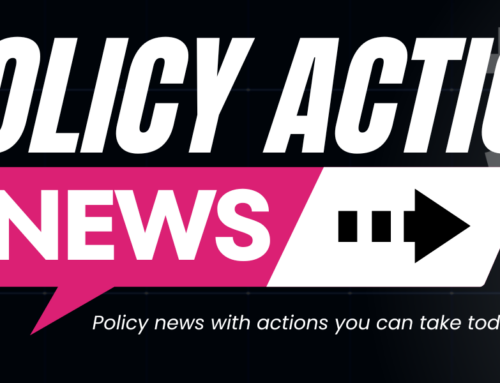
February 8, 2021: Folks, we have a new president–and with that, we have a whole lot of new executive orders. If you got a little lost in the flurry of papers coming out of the White House, you are not alone. We are here to help break down what these orders are and which ones affect women and people of trans experience living with HIV.
You may be asking yourself, “What exactly is an executive order?”
The president is the head of the executive branch of government, including all the administrative agencies, like the Department of Health and Human Services. Because the president oversees “executing the laws”– i.e., putting what Congress passes into action—they are also able to explain to the employees of the executive branch how they think laws should be interpreted or applied.
Executive orders are the written directives that provide the president’s interpretation of the law to these employees. Because these employees then put that interpretation into action, it has concrete effects for our daily lives.
Now that you know what an executive order is, let’s get into what the newest ones from President Biden are.
Executive Order | What it does and what is its purpose | How this affects women living with HIV |
Executive Order on Advancing Racial Equity and Support for Underserved Communities Through the Federal Government | The purpose is to advance equity across the federal government; a main component of this is revoking a Trump-era executive order which banned federal contractors from engaging in diversity and inclusion training. | This revokes prior executive orders which made it so that many organizations which rely on government funding, such as nonprofits, universities, employers, community-based organizations, and AIDS service organizations, would have to choose between receiving necessary funding and training employees to provide informed service and combat racism. It made necessary programs less accessible and welcoming for BIPOC and LGBTQ+ communities because of the lack of informed training for employees. Removing this order was an important first step in working towards equity. |
Executive Order on Ensuring a Lawful and Accurate Enumeration and Apportionment Pursuant to the Decennial Census | This executive order aims to ensure that the census count accurately counts every person in the country, as required by the Constitution. It revokes a Trump-era executive order which aimed to exclude undocumented immigrants from the census to the maximum amount feasible. | An accurate census count is essential for determining how funds are distributed to states and localities and it also impacts an area’s representation in Congress. These funds are for programs we rely on every day for food, health care, and housing, like Medicaid, Medicare, the Supplemental Nutrition Assistance Program (SNAP), and public housing. This will ensure immigrants living with HIV who responded to the census are counted and that their communities get the political power and resources that they deserve. |
Executive Order on Preventing and Combating Discrimination on the Basis of Gender Identity or Sexual Orientation | This order instructs federal agencies to prioritize enforcing the Supreme Court’s Bostock decision which prohibited employment discrimination based upon gender identity or sexual orientation. | The administration is taking discrimination against LGBTQ+ folks seriously and ensuring the Bostock decision is enforced in virtually all federal programs, like public accommodations, education employment and housing. This is especially important for people of trans experience, who face significant barriers to employment, housing, and health services, which may increase vulnerability to acquiring HIV. |
Executive Order on Ensuring an Equitable Pandemic Response and Recovery | This EO creates the COVID- 19 Health Equity Task Force, tasked with addressing COVID-19’s impact on Black, Indigenous and other communities of color as well as other underserved populations. | The Task Force provides for the express inclusion of people with lived experience and will recommend how to best allocate COVID-19 resources; disburse funds in a manner that advances equity; and deliver effective, culturally aligned communication, messaging, and outreach to communities of color and other underserved populations. These communities are also the ones most impacted by the HIV epidemic, so this prioritization and focus will help women living with HIV who simultaneously more at risk for acquiring COVID-19. |
Executive Order on Protecting Worker Health and Safety | This order aims to reduce the risks workers face for acquiring COVID-19 while on the job by issuing revised guidance for employers and, if necessary, issuing new OSHA standards. | Protecting essential workers will inevitably protect women living with HIV as well. Women living with HIV may be essential workers themselves, in which case these new guidelines and standards will help keep them safer as they enter their workplaces. Safer workplaces will also benefit people living with HIV who have to access places where these workers are, like grocery stores and health care settings. |
Executive Order on Supporting the Reopening and Continuing Operation of Schools and Early Childhood Education Providers | This order aims to support high-quality education for all children and the safe reopening of schools for in-person learning by providing guidance for states, schools, and child care providers to use in deciding whether and how to reopen as well as developing a way for schools to share lessons learned and best practices. It also directs the creation of a report on disparate impacts of COVID-19 on students and ways to address it as well as finding ways to increase connectivity for students lacking reliable internet | Many women living with HIV and people of trans experience living with HIV are parents and need safe places to send their children where they will not contract COVID-19. This guidance can help increase confidence that sending children back into group learning environments is being done in a way that is consistent with the best available scientific data and public health research. Further, being unable to send children to school or have access to childcare can negatively impact a person financially and can be an additional stressor, especially if wireless connectivity is an issue for at home learning. Finding solutions to these problems, which disproportionately impact BIPOC communities, is essential, so it is fantastic that the administration is prioritizing it. |
Executive Order on Enabling All Qualified Americans to Serve Their Country in Uniform | This order revokes a Trump-era ban and will allow people of trans experience to serve openly in the military. | The prior ban was arbitrary, discriminatory and perpetuated stigmatizing notions of people of trans experience and non-binary people. It is a good sign that the new president is including and centering transgender folks in his initial actions and, as advocates, we must encourage him to continue to do so in all other areas of his policy agenda. |
Executive Order on Strengthening Medicaid and the Affordable Care Act | This executive order permits HHS to open HealthCare.gov for a “Special Enrollment Period,” from February 15, 2021 – May 15, 2021, meaning that people have additional opportunities to sign up for health care coverage. The order directs federal agencies to reconsider rules and policies that limit access to health care and consider actions that will protect and strengthen that access. | The ACA significantly expanded access to care for women living with HIV but faced a concerted attack during the Trump era. This executive order begins the process of unwinding that damage and improving access to care even further. Especially of concern is access to care for those who live in states whose elected leaders have not expanded Medicaid, people who live in rural areas, and lifting the federal ban on abortion coverage. Ideally, this review will also demonstrate the need for a publicly funded coverage option as an alternative to the private insurance market, which is driven by profit and private interests instead of public health. |
President Biden took other important steps as well, which were not styled as executive orders but were either memorandums to agency officials or proclamations.
In one such memorandum, President Biden froze the implementation of Trump-era regulations pending his review. This halts the SUNSET Rule, which would have required the Department of Health and Human Services to reassess the economic impacts of its regulations every ten years. If the regulation was not reviewed, it would “sunset” or cease to have any enforcement power. This was an extremely time consuming, wasteful, and burdensome regulation that would have impacted programs like Ryan White. During this regulatory freeze period, advocates should encourage the Biden administration to reject the SUNSET Rule.
President Biden revoked the global gag rule, which prevented international non-profits that provide abortion counseling or referrals from receiving U.S. funding, and directed HHS to review a similar rule that is used in the United States, referred to as the domestic gag rule or the Title X rule. It also directed the Secretary of State to reestablish the flow of funds to United Nations Population Fund, which supports reproductive rights for all and widely available sexual and reproductive health services. President Biden also withdrew the anti-choice and anti-LGBT Geneva Consensus Declaration. These steps are crucial in ensuring comprehensive access to health care for all people, including abortion care. It is essential that HHS rescind the Title X Rule and, to ensure the global gag rule is not put into place by future administrations, Congress must pass the Global Health, Empowerment and Rights (HER) Act.
President Biden also extended the pause on federal student loan payments. Student loan debt disproportionately burdens BIPOC and low-income communities who are also disproportionately impacted by HIV epidemic. Although more can be done to address this inequity, a pause on payments during the coronavirus pandemic is an important first step.
Finally, President Biden issued a proclamation Preserving and Fortifying Deferred Action for Childhood Arrivals (DACA). The Trump administration had led a concerted effort for the past four years to undermine the DACA program and had stopped accepting DACA applications. President Biden will now allow the program to begin accepting applications again so DACA recipients and DACA eligible individuals can receive all the benefits they are entitled to under the program.
In his first several days in office, President Biden has taken many important steps to roll back harmful policies championed by the Trump Administration. We hope that as this administration moves forward into implementing its own policies, it takes a racial and gender justice approach to its work.



